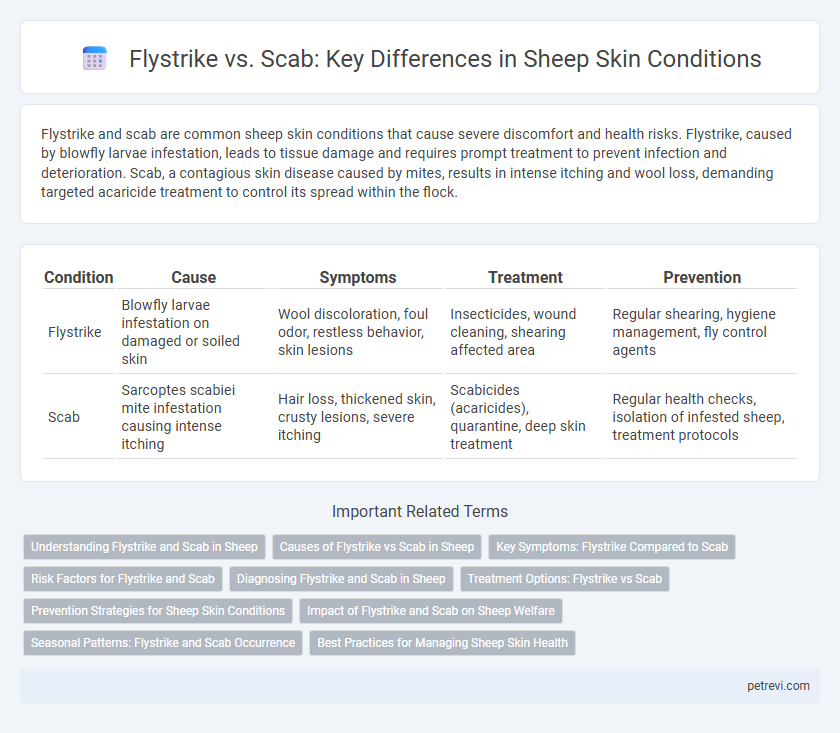Flystrike and scab are common sheep skin conditions that cause severe discomfort and health risks. Flystrike, caused by blowfly larvae infestation, leads to tissue damage and requires prompt treatment to prevent infection and deterioration. Scab, a contagious skin disease caused by mites, results in intense itching and wool loss, demanding targeted acaricide treatment to control its spread within the flock.
Table of Comparison
| Condition | Cause | Symptoms | Treatment | Prevention |
|---|---|---|---|---|
| Flystrike | Blowfly larvae infestation on damaged or soiled skin | Wool discoloration, foul odor, restless behavior, skin lesions | Insecticides, wound cleaning, shearing affected area | Regular shearing, hygiene management, fly control agents |
| Scab | Sarcoptes scabiei mite infestation causing intense itching | Hair loss, thickened skin, crusty lesions, severe itching | Scabicides (acaricides), quarantine, deep skin treatment | Regular health checks, isolation of infested sheep, treatment protocols |
Understanding Flystrike and Scab in Sheep
Flystrike in sheep occurs when blowflies lay eggs on damp, damaged wool, leading to maggot infestation that causes severe tissue damage and distress. Scab is a contagious skin disease caused by the mite Psoroptes ovis, resulting in intense itching, wool loss, and skin crusting. Early detection and treatment are crucial to prevent significant health decline and economic losses in sheep farming.
Causes of Flystrike vs Scab in Sheep
Flystrike in sheep is primarily caused by blowflies laying eggs on damp, soiled, or damaged wool, leading to maggot infestation that damages the skin. Scab, on the other hand, results from an infestation of the mite Psoroptes ovis, which burrows into the skin causing intense itching and irritation. Environmental factors such as wet weather can increase susceptibility to flystrike while close contact and poor hygiene contribute to the spread of scab.
Key Symptoms: Flystrike Compared to Scab
Flystrike in sheep is characterized by maggot infestation causing intense itching, foul odor, and moist, discolored skin, primarily around the breech and tail areas. In contrast, scab results from mite infestation leading to intense itching, skin redness, crusting, and wool loss, commonly spreading over the body. Both conditions cause significant distress and wool damage but differ in their causative agents and visual symptoms, requiring distinct treatment approaches.
Risk Factors for Flystrike and Scab
Flystrike risk factors in sheep include moist, dirty wool, skin wounds, and poor shearing practices, which create an ideal environment for blowfly larvae infestation. Scab is caused by the Psoroptes ovis mite, with risk factors such as close animal contact, overcrowding, and inadequate biosecurity. Both conditions thrive in damp, warm weather, increasing susceptibility and spread within flocks.
Diagnosing Flystrike and Scab in Sheep
Diagnosing flystrike in sheep involves identifying moist, discolored, and maggot-infested wool, often accompanied by an offensive odor and restless behavior. Scab diagnosis requires detecting intense itching, wool loss, and crusty lesions caused by the Psoroptes ovis mite, confirmed through skin scrapings examined under a microscope. Accurate differentiation relies on clinical signs alongside microscopic analysis to ensure effective treatment and control measures.
Treatment Options: Flystrike vs Scab
Flystrike in sheep requires prompt treatment with insecticides such as cyromazine or diazinon to kill larvae and prevent further infestation, while severe cases may necessitate shearing and wound debridement. Scab treatment focuses on acaricides like ivermectin or moxidectin to eliminate the Psoroptes ovis mites responsible for the condition, often combined with environmental management to reduce transmission. Both treatments demand careful monitoring and follow-up to ensure complete recovery and minimize resistance development in parasites.
Prevention Strategies for Sheep Skin Conditions
Flystrike and scab are common and severe skin conditions in sheep caused by parasitic infestations, with flystrike resulting from blowfly larvae and scab caused by mites. Effective prevention strategies include regular monitoring and inspection of sheep for early signs, maintaining good hygiene and proper shearing practices, and applying appropriate insecticides or acaricides to control parasite populations. Implementing biosecurity measures to isolate affected animals and using resistant sheep breeds also contribute significantly to reducing the incidence of these skin conditions.
Impact of Flystrike and Scab on Sheep Welfare
Flystrike causes severe skin damage by attracting blowflies that lay eggs, leading to maggot infestations and intense pain for affected sheep. Scab, caused by mites burrowing into the skin, results in itching, wool loss, and secondary infections, significantly compromising sheep comfort and health. Both conditions reduce productivity and increase mortality rates, highlighting the critical need for effective management to safeguard sheep welfare.
Seasonal Patterns: Flystrike and Scab Occurrence
Flystrike in sheep typically escalates during the warmer, wetter months when blowflies are most active, particularly from late spring through early autumn. Scab, caused by mites, often peaks in colder seasons as sheep spend more time in close contact, facilitating mite transmission. Understanding these seasonal patterns is crucial for implementing timely interventions to reduce the incidence of both flystrike and scab in sheep flocks.
Best Practices for Managing Sheep Skin Health
Flystrike in sheep, caused by blowflies laying eggs on damp or soiled wool, requires prompt treatment with insecticides and regular crutching to reduce infection risk. Scab, a contagious mite infestation, demands strategic application of acaricides and strict biosecurity measures to prevent flock-wide outbreaks. Integrating preventative shearing, nutritional management, and environmental control optimizes sheep skin health and minimizes the incidence of both flystrike and scab.
Flystrike vs Scab for Sheep Skin Conditions Infographic

 petrevi.com
petrevi.com